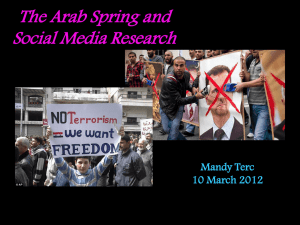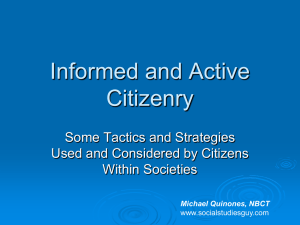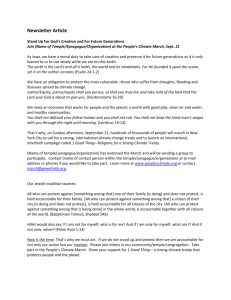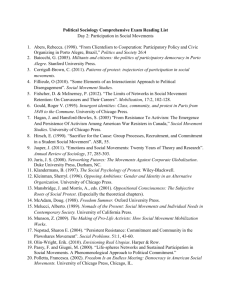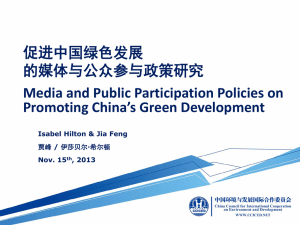continuity and change: protest event analysis of the australian
advertisement
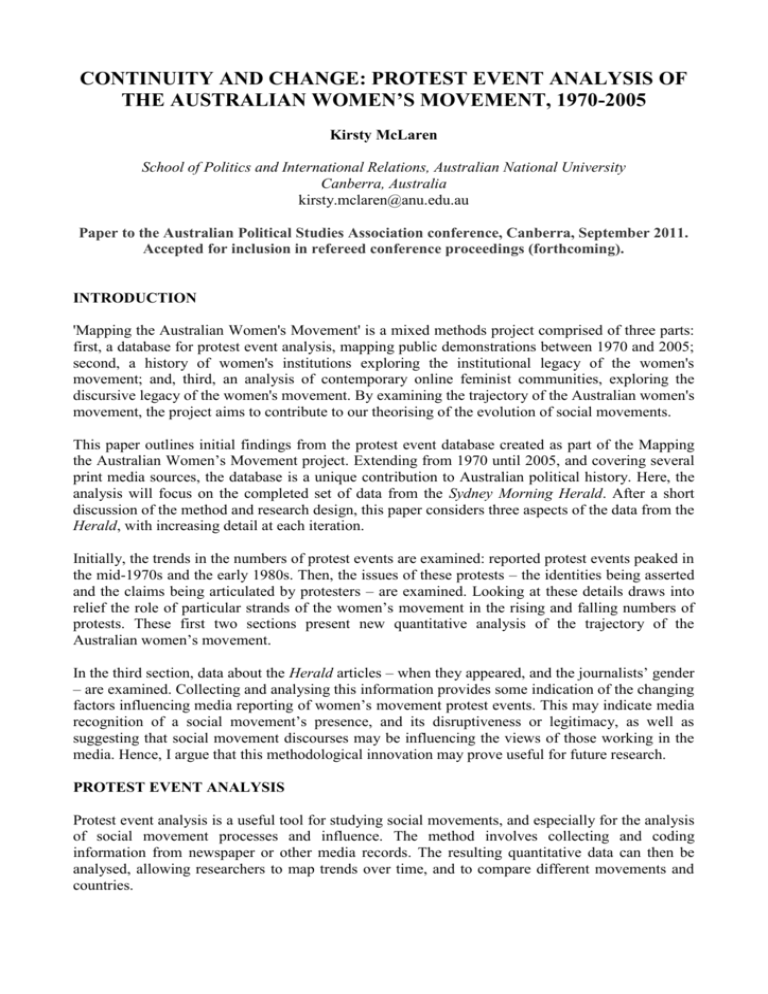
CONTINUITY AND CHANGE: PROTEST EVENT ANALYSIS OF THE AUSTRALIAN WOMEN’S MOVEMENT, 1970-2005 Kirsty McLaren School of Politics and International Relations, Australian National University Canberra, Australia kirsty.mclaren@anu.edu.au Paper to the Australian Political Studies Association conference, Canberra, September 2011. Accepted for inclusion in refereed conference proceedings (forthcoming). INTRODUCTION 'Mapping the Australian Women's Movement' is a mixed methods project comprised of three parts: first, a database for protest event analysis, mapping public demonstrations between 1970 and 2005; second, a history of women's institutions exploring the institutional legacy of the women's movement; and, third, an analysis of contemporary online feminist communities, exploring the discursive legacy of the women's movement. By examining the trajectory of the Australian women's movement, the project aims to contribute to our theorising of the evolution of social movements. This paper outlines initial findings from the protest event database created as part of the Mapping the Australian Women’s Movement project. Extending from 1970 until 2005, and covering several print media sources, the database is a unique contribution to Australian political history. Here, the analysis will focus on the completed set of data from the Sydney Morning Herald. After a short discussion of the method and research design, this paper considers three aspects of the data from the Herald, with increasing detail at each iteration. Initially, the trends in the numbers of protest events are examined: reported protest events peaked in the mid-1970s and the early 1980s. Then, the issues of these protests – the identities being asserted and the claims being articulated by protesters – are examined. Looking at these details draws into relief the role of particular strands of the women’s movement in the rising and falling numbers of protests. These first two sections present new quantitative analysis of the trajectory of the Australian women’s movement. In the third section, data about the Herald articles – when they appeared, and the journalists’ gender – are examined. Collecting and analysing this information provides some indication of the changing factors influencing media reporting of women’s movement protest events. This may indicate media recognition of a social movement’s presence, and its disruptiveness or legitimacy, as well as suggesting that social movement discourses may be influencing the views of those working in the media. Hence, I argue that this methodological innovation may prove useful for future research. PROTEST EVENT ANALYSIS Protest event analysis is a useful tool for studying social movements, and especially for the analysis of social movement processes and influence. The method involves collecting and coding information from newspaper or other media records. The resulting quantitative data can then be analysed, allowing researchers to map trends over time, and to compare different movements and countries. For this database, a protest event is defined as organised collective action aiming to achieve change in society; with a beginning and end point; with some performative or unconventional element that distinguishes it from everyday activities; and public, in some way communicating with other members of society. To be a women’s movement event, the protesters’ claims must be framed for women, or as women (see Sawer, 2010: 605-606). The database combines mainstream and alternative media sources. Generally, researchers using protest event analysis have had to use a sample of newspapers – scanning, for instance, one newspaper a week, to gain a representative sample. Newer searchable digital archives have allowed us to achieve close to total coverage of a single publication, using Boolean search terms to find relevant articles. The newly digitised Sydney Morning Herald archives extend until September 1986, when the Factiva database coverage commences. Searches, using ‘(women* OR feminis*) AND (protest* OR demonstrat*)’ led to articles about 332 events (though several of these events were covered by more than one article). This major source is complemented by a complete reading of the Tribune archives, and the Women’s Electoral Lobby newsletter, WELinformed. Events documented in histories of the women’s movement and other scholarly publications are also being collated. As this other work is still being completed, this paper presents some of the initial analysis of the data from the Sydney Morning Herald. This data includes information in seventeen fields, comprising factual information about date and place, numbers and identified organisations, brief descriptions of the event and claims, qualitative coding of the type of event and issues raised, and references to the source. With such detail, it is easy to think of this as a complete historical record. Indeed, one of the attractions of protest event analysis as a method is its usefulness when studying and comparing movements across time and space. Yet, as Koopmans and Rucht (2002) caution, researchers must be cognisant of the shortcomings of this method. Most significantly, protest event analysis charts media reports of events, not events themselves. This database, then, maps not women’s movement activity, but rather the visibility of the women’s movement in the media. Many scholars have pointed out that masculine models of protest and politics may not be relevant for analysing women’s movement political activity. Bagguley (2010) has recently questioned whether protest event analysis is suitable for studying the women’s movement; Grey (2010) has argued that protest event analysis requires careful modification, to account for media biases and shortcomings in existing theories of social movement repertoires. Certainly, the method’s emphasis on ‘public’ events ignores feminist critiques of the public/private dichotomy; it also excludes many activities which activists themselves see as the core of their activism. For instance, private consciousness-raising events were extremely political, and helped second-wave feminists to formulate their ideas and activities. On the other hand, though, media coverage is undoubtedly a crucial aspect of social movement activism, and hence worth studying: PEA [protest event analysis] … is based on a constructed reality. This constructed reality, however, is of extreme importance for both policymakers and the wider public. We observe our social and political world mainly through the mass media. In a certain sense, protests and other events that remain unreported are simply “non-existent” …for most people (Koopmans and Rucht, 2002: 252). Indeed, the media can create the co-presence which is vital to social and political communication (Sewell, 2001: 57-58). Although this is very different to participants’ experience of co-presence and their perspective on the meaning of an event (Della Porta, 2008), media coverage is generally a key consideration of activists themselves (Meyer and Staggenborg, 2007; Taylor and Van Dyke, 2004). In this project, then, the protest event analysis is part of a ‘triangulation’ of several methods (Klandermans, Staggenborg and Tarrow, 2002): we are not assuming that this will create a complete picture of the women’s movement. This triangulation makes it easier to reflect on the strengths and weaknesses of the method. In the final section of this paper, I will suggest that the method is nonetheless insightful, and that data about media coverage itself provides useful insight into the impact of the women’s movement. First, though, the paper will discuss the initial findings from the database. WOMEN’S MOVEMENT PROTEST EVENTS The Sydney Morning Herald data shows several noteworthy trends. Fig. 1 shows the number of events reported each year. Though these were the early years of the ‘second-wave’ women’s movement – Women’s Liberation was formed in Sydney in 1970, for instance – there are significant numbers of events from the start of the study period. There are two defined peaks centred around 1975 and 1983. The 1975 peak can be linked to International Women’s Year. However, whilst there were some events marking International Women’s Day, the impact was not so straightforward: most of the events that year were not specifically about the United Nations year. Rather, activism, the assertion of women’s identities and rights, and celebration seem to have been bolstered by the special year. A case study of International Women’s Day events (contrasted with a case study of Reclaim the Night events) will be undertaken to examine how these annual occasions have changed. Figure 1: Women’s movement protest events reported in the Sydney Morning Herald, 19702005. The number of events declined markedly after the mid-1980s. Indeed, the numbers from the Herald archives alone are so low as to make it difficult to identify meaningful trends in the latter half of the study period. Nonetheless, protest events continue: even in this register of political activity, the women’s movement has not disappeared (see Andrew and Maddison, 2010; Sawer 2010). Interestingly, the data seems to indicate an increasing tendency for women’s organisations to be involved in organising and publicising protest events during this latter time period, although there are too few events in this part of the database to regard this as a significant change. Adding in data from other publications will hopefully provide a better picture. ISSUES AND CLAIMS Turning to the specific issues raised by women’s movement events provides greater detail about continuity and change. The database includes two ‘layers’ of qualitative codes describing issues. First, broad thematic codes are used to identify the general areas about which concerns were raised (such as equality, economic matters, culture, etc). A second, discrete layer of codes identifies more specific issues and claims (such as racism, equal pay, women’s role in the churches, etc). These two independent sets of codes were created to serve two purposes: the first is inclusive, intended to represent the full spectrum of women’s claims in broad brush-strokes; the second is more narrow, allowing precise tracking of many of the major matters raised by women’s protests, without aiming to be exhaustive. Here, the first, broad set of themes is examined. An event could be coded as having two themes, in which case the first is attributed 2/3 of the weight, and the second 1/3. For instance, an International Women’s Day event where protesters articulated claims to reproductive rights, as well as Indigenous women’s right to equality, would be assigned two weighted codes. This is an imperfect quantification, but gives an approximate reflection of the how the media coverage has represented the majority of events, with one claim or collection of claims dominating the headline and reporting. Three of these were particularly evident in the Herald data. ‘REPRODUCTIVE HEALTH’, a code which encompassed reproductive rights, abortion law reform and access to abortion, access to contraception, and women’s health care, was an ongoing issue, raised in a significant number of protests throughout the period (see Fig. 2). ‘EMPLOYMENT’, a code which included claims for equal pay, equal opportunity and employment conditions, was also a significant issue, though it became less common in the latter years (see Fig. 3). The women’s peace movement, though, is especially noteworthy: without this element of the women’s movement, the second peak in women’s movement events would be far less pronounced, and occur earlier. Fig. 4 compares the total number of events with those coded as about ‘PEACE’, which encompasses women’s groups (collectively identifying as women, with a special, gendered view) demonstrating for peace, for nuclear disarmament, against the Australian-American alliance or American bases in Australia, or about the impact of war, and especially rape, on women. The women’s peace movement is an especially strong example of the intersections between different social movements. This intersecting connection was also strongly evident in other countries, such as the United Kingdom. Women’s peace activism also illustrates the many different ways in which individuals and groups have conceptualised and represented women as a collective identity and political constituency. For instance, as a particularly stark contrast, some of the events ‘Campaign Against Rising Prices’ of the early 1970s’ made claims for women as housewives and mothers, protesting rising prices and restrictions on trading stamps and coupons, whilst at the same time Women’s Liberation was beginning to contest such accounts of women’s identities. Figure 2: Women’s movement protest events about reproductive rights and health, compared to other issues, Sydney Morning Herald, 1970-2005. Figure 3: Women’s movement protest events about employment, compared to other issues, Sydney Morning Herald, 1970-2005. Figure 4: Women’s movement protest events about peace, compared to other issues, Sydney Morning Herald, 1970-2005. MEDIA REPORTING Thus far, this paper has discussed the number of events reported. Yet, the media coverage of these events itself involves noteworthy trends. The database has been constructed to provide some detail about how many articles appeared about events, and when they appeared. Firstly, the number of articles about women’s movement events actually exaggerated the trends. Fig. 5 compares the number of events with the number of articles reporting or commenting on them. In this section, the period up until 1985 is being graphed (as the number of events after this decline quickly). Figure 5: Number of articles about women’s movement protest events, compared to number of reported events, Sydney Morning Herald, 1970-1985. There are two important characteristics to Fig. 5. First, the number of articles increases as the years progress. This is congruent with the assumption that media organisations may under-report social movement events early in a period of increased activism, because journalists and editors may not see the emerging movement claims as newsworthy. Likewise, it is assumed that coverage may also lag behind when the number of events begins to decline, continuing to show artificially high levels of social movement activity during that lag period. (With the already small number of events reported from the late 1980s until the end of the survey period, it is difficult to judge whether such an ‘inflationary’ lag was in effect: another good reason to focus on the earlier period.) The second characteristic, the very high number of articles in 1983, is attributable to women’s peace movement events of that year, which garnered a lot of coverage. Amenta et al., in their largescale review of coverage of social movement organisations, identified three criteria which usually determined whether an organisation’s concerns would be reported: size or scale; disruptiveness; and the media’s sense of what is an ‘issue’. They defined disruption as “illegal collective action or disruptive collective action such as strikes, boycotts, occupations, and unruly mass protests drawing the reaction of authorities, and/or collective action in which violence was involved, whether by the movement, authorities, or opponents of the movement” (2009: 21). As Bagguley argues, this kind of disruptiveness is conventionally masculine, and thus women’s movement events, less likely to use such tactics, may not be covered (2010). Yet this disproportionate coverage of women’s peace movement events shows that disruption of gender roles or social norms may also be sufficiently transgressive to gain media attention. The women’s peace camp of 1983 was successful partly because of the perceived sensation of activists declaring a ‘women only’ zone. Similarly, the novelty of ‘dress-up’ events of the 1970s, in which cross-dressing participants protested against the exclusion of women from public bars, likely helped comparatively small events to gain media coverage. Scalmer (2002) describes how powerful the ‘political gimmick’ can be, gaining publicity by evoking shock; disrupting gender norms has proven a sure way to shock. This is not to say that such shock has been a mere tactic. Gender norms have often been the very matters being contested, and the ‘shocking’ acts perform or enact that substantive contention (on contention, see McAdam et al. 2001). Nonetheless, as well as attracting initial coverage, especially novel or disruptive events have also practically demanded further analysis and comment, leading to repeat coverage in feature and opinion articles. Lester (1980) argues that ‘newsworthiness’ is socially constructed through journalists’ and editors’ interactions (also cited by Bagguley 2010). This attribution of ‘newsworthiness’ also appears to be reflected in the number of articles about events which are yet to happen. Fig. 6 shows the proportion of articles about future events. The increasing number of articles written before the event occurred seem to reflect two trends: a growing recognition that women’s movement events were noteworthy or disruptive, and a growing recognition of women’s movement events as legitimate community events. At this preliminary stage, the latter seems to be linked to the increasing role of women’s institutions in organising and publicising events such as International Women’s Day and Reclaim the Night. Figure 6: Number of articles appearing about future women’s movement protest events, compared to number appearing after events, Sydney Morning Herald, 1970-1985. A final factor to consider is the gender of journalists themselves. Bagguley hypothesises that the mostly male journalists might have their own selection bias, and be less likely to report on the women’s movement (2010: 618). Fig. 7 shows the gender of journalists in articles on the women’s movement. Though historically underrepresented in the profession, women journalists have been disproportionately involved in reporting on women’s movement events. Partly, this may be due to supervisors assigning ‘women’s issues’ to women; it may also indicate active attempts by women journalists to cover those events, because of a belief that the events were newsworthy. Further research would be needed to gauge the relative impacts of these three factors. Figure 7: Gender of journalists reporting on women’s movement protest events, Sydney Morning Herald, 1970-1985. It is important to remember that social movements are amorphous and intangible, large numbers of individuals and groups who share collective identities and ideas. Journalists, editors and media organisations are themselves part of society, and thus may be influenced by – or part of – social movements. So media biases are important in shaping media reporting, but this analysis shows that these influences may operate in multiple ways. CONCLUSION Protest event analysis is an extremely valuable method of quantifying trends in the public aspects of social movement activity. It is also, however, heavily dependent on media sources, and should therefore be understood as charting media reporting of protest events, rather than events themselves. This paper has outlined initial data about visible protests by the women’s movement in Australia. It has also described a methodological innovation – collation and analysis of significant detail about media reports – that provides more sophisticated insight into protest event analysis. In this, it concurs with Grey’s assessment of the method as valuable, but demanding a careful, reflexive approach (2010). Whilst our preliminary analysis supports the general conclusions of the literature on media reporting of social movement activity, it also shows that there is considerable complexity to how the criteria of ‘newsworthiness’ intersect with sexism and gender norms. Indeed, it is only through the collation of this data – through protest event analysis – that these intersections can be identified. The final analysis of the completed database will provide greater detail about changes in protest tactics, and much more detailed work on participant numbers, organisations, and the claims articulated. Moreover, the comparisons between this and the other two components of the Mapping the Australian Women’s Movement promise to be most insightful. ACKNOWLEDGEMENTS I would like to acknowledge Marian Sawer’s guidance and advice, and Gillian Evans’ invaluable research work on the database. I would also like to acknowledge the anonymous reviewers’ comments, which improved the final draft. An earlier version of some of the material in this paper was presented at the ACSPRI Social Science Methodology Conference 2010 (McLaren 2010). The Mapping the Australian Women’s Movement project is supported by Australian Research Council grant DP0878688. REFERENCES Amenta, E, Caren, N, Olasky, S.J. and Stobaugh, J.E. (2009), All the Movements Fit to Print: Who, What, When, Where, and Why SMO Families Appeared in the New York Times in the Twentieth Century, American Sociological Review, 74(4), 636-656. Andrew, M. and Maddison, S. (2010), Damaged but Determined: The Australian Women’s Movement, 1996-2007, Social Movement Studies, 9(2), 171-285. Bagguley, P. (2010), The Limits of Protest Event Data and Repertoires for the Analysis of Contemporary Feminism, Politics & Gender, 6(4), 616-621. Della Porta, D. (2008), Eventful Protest, Global Conflicts, Distinktion, 17, 27-56. Grey, S. (2010), When No “Official Record” Exists? Politics & Gender, 6(4), 622-629. Klandermans, B, Staggenborg, S. and Tarrow, S. (2002), Conclusion: blending Methods and Building Theories in Social Movement Research, in Methods of Social Movement Research, Eds Klandermans B. and Stagganborg S. Minnesota: University of Minnesota Press, 314-349. Koopmans, R. and Rucht, D. (2002), Protest Event Analysis, in Methods of Social Movement Research, Eds Klandermans B. and Staggenborg S. Minnesota: University of Minnesota Press, 231-259. Lester, M. (1980), Generating Newsworthiness: the Interpretive Construction of Public Events’, American Sociological Review, 45, 989-994. McAdam, D, Tarrow, S. and Tilly, C. (2001), Dynamics of Contention, Cambridge: Cambridge University Press. McLaren, K. (2010), Media reporting of the women’s movement, paper to the Australian Consortium for Social and Political Research, Inc. Social Science Methodology Conference 2010, Sydney, December. Meyer, D.S. and Staggenborg, S. (2007), Thinking about strategy, paper to ‘Movement Cultures, Strategies and Outcomes’, American Sociological Association, Collective Behavior/Social Movement Section Workshop, Hofstra University, New York, August. Sawer, M. (2010), Premature Obituaries: How Can We Tell if the Women’s Movement is Over? Politics & Gender, 6(4), 602-609. Scalmer, S. (2002), Dissent Events: Protest, the Media and the Political Gimmick in Australia, Sydney: University of New South Wales Press. Sewell, W.H. Jr (2001), Space in Contentious Politics, in Silence and Voice in the Study of Contentious Politics, Eds Aminzade, R.R. et al. Cambridge: Cambridge University Press, 5188. Taylor, V. and Van Dyke, N. (2004), “Get up, Stand up”: Tactical Repertoires of Social Movements, in The Blackwell Companion to Social Movements, Eds David A. Snow, D.A, Soule, S.A. and Kriesi, H. Carlton, Vic.: Blackwell, 262-293.

![The Politics of Protest [week 3]](http://s2.studylib.net/store/data/005229111_1-9491ac8e8d24cc184a2c9020ba192c97-300x300.png)
